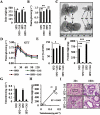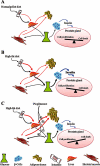Pioglitazone attenuates prostatic enlargement in diet-induced insulin-resistant rats by altering lipid distribution and hyperinsulinaemia
- PMID: 20726985
- PMCID: PMC3010577
- DOI: 10.1111/j.1476-5381.2010.00994.x
Pioglitazone attenuates prostatic enlargement in diet-induced insulin-resistant rats by altering lipid distribution and hyperinsulinaemia
Abstract
Background and purpose: Increased incidence of benign prostatic hyperplasia among insulin-resistant individuals suggests a role for hyperinsulinaemia in prostatic enlargement. We have already reported increased cell proliferation and enlargement of prostate gland in insulin-resistant rats. The present study aimed to elucidate the molecular mechanisms underlying the reversal of prostatic enlargement in insulin-resistant rats by the peroxisome proliferator-activated receptor γ agonist pioglitazone.
Experimental approach: Sprague-Dawley rats were fed a normal pellet or a high-fat diet for 12 weeks with or without pioglitazone (20 mg·kg(-1)). Subgroups of animals fed different diets were castrated. Effects of dietary manipulation and pioglitazone were measured on insulin sensitivity, lipid distribution, cell proliferation and apoptosis.
Key results: A high-fat diet led to the accumulation of fat in non-adipose tissues, insulin resistance, compensatory hyperinsulinaemia and prostatic enlargement in rats. Pioglitazone treatment altered fat distribution, improved insulin sensitivity and normalized lipid and insulin level in rats on the high-fat diet. The improved metabolic parameters led to decreased cellular proliferation and increased apoptosis in the prostate gland. High-fat diet feeding and pioglitazone treatment did not change plasma testosterone levels. However, significant prostatic atrophy was observed in castrated rats irrespective of dietary intervention.
Conclusions and implications: Our results show a previously unexplored therapeutic potential of pioglitazone for prostatic enlargement under insulin-resistant condition and further suggest that targeting distribution of lipid from non-adipose tissue to adipose tissue and insulin signalling could be new strategies for the treatment of benign prostatic hyperplasia.
© 2010 The Authors. British Journal of Pharmacology © 2010 The British Pharmacological Society.
Figures







Comment in
-
Re: Pioglitazone attenuates prostatic enlargement in diet-induced insulin-resistant rats by altering lipid distribution and hyperinsulinaemia.J Urol. 2011 Dec;186(6):2496-7. doi: 10.1016/j.juro.2011.08.035. Epub 2011 Oct 22. J Urol. 2011. PMID: 22078628 No abstract available.
Similar articles
-
Increased cell proliferation and contractility of prostate in insulin resistant rats: linking hyperinsulinemia with benign prostate hyperplasia.Prostate. 2010 Jan 1;70(1):79-89. doi: 10.1002/pros.21041. Prostate. 2010. PMID: 19790233
-
Pioglitazone improves lipid and insulin levels in overweight rats on a high cholesterol and fructose diet by decreasing hepatic inflammation.Br J Pharmacol. 2010 Aug;160(8):1892-902. doi: 10.1111/j.1476-5381.2010.00671.x. Epub 2010 Mar 8. Br J Pharmacol. 2010. Retraction in: Br J Pharmacol. 2024 Sep;181(17):3300. doi: 10.1111/bph.16498. PMID: 20233219 Free PMC article. Retracted.
-
Insulin-resistance reduces botulinum neurotoxin-type A induced prostatic atrophy and apoptosis in rats.Eur J Pharmacol. 2011 Jan 10;650(1):356-63. doi: 10.1016/j.ejphar.2010.09.066. Epub 2010 Oct 15. Eur J Pharmacol. 2011. PMID: 20940009
-
Peroxisome proliferator-activated receptor-γ (PPAR-γ) agonists on glycemic control, lipid profile and cardiovascular risk.Curr Mol Pharmacol. 2012 Jun;5(2):272-81. doi: 10.2174/1874467211205020272. Curr Mol Pharmacol. 2012. PMID: 22122457 Review.
-
[Insulin resistance-reducing effect of a new thiazolidinedione derivative, pioglitazone].Nihon Yakurigaku Zasshi. 2001 May;117(5):335-42. doi: 10.1254/fpj.117.335. Nihon Yakurigaku Zasshi. 2001. PMID: 11411343 Review. Japanese.
Cited by
-
Parental High-Fat Diet Promotes Inflammatory and Senescence-Related Changes in Prostate.Oxid Med Cell Longev. 2017;2017:4962950. doi: 10.1155/2017/4962950. Epub 2017 Feb 5. Oxid Med Cell Longev. 2017. PMID: 28261375 Free PMC article.
-
Pioglitazone, a PPARγ agonist rescues depression associated with obesity using chronic unpredictable mild stress model in experimental mice.Neurobiol Stress. 2016 May 18;3:114-121. doi: 10.1016/j.ynstr.2016.05.001. eCollection 2016 Jun. Neurobiol Stress. 2016. PMID: 27981184 Free PMC article.
-
Role of PKC and CaV1.2 in detrusor overactivity in a model of obesity associated with insulin resistance in mice.PLoS One. 2012;7(11):e48507. doi: 10.1371/journal.pone.0048507. Epub 2012 Nov 7. PLoS One. 2012. PMID: 23144896 Free PMC article.
-
High-Fat Diet Induced Gut Microbiota Alterations Associating With Ghrelin/Jak2/Stat3 Up-Regulation to Promote Benign Prostatic Hyperplasia Development.Front Cell Dev Biol. 2021 Jun 24;9:615928. doi: 10.3389/fcell.2021.615928. eCollection 2021. Front Cell Dev Biol. 2021. PMID: 34249898 Free PMC article.
-
17-β Oestradiol prevents cardiovascular dysfunction in post-menopausal metabolic syndrome by affecting SIRT1/AMPK/H3 acetylation.Br J Pharmacol. 2013 Oct;170(4):779-95. doi: 10.1111/bph.12290. Br J Pharmacol. 2013. PMID: 23826814 Free PMC article.
References
-
- Attia N, Tamborlane WV, Heptulla R, Maggs D, Grozman A, Sherwin RS, et al. The metabolic syndrome and insulin-like growth factor I regulation in adolescent obesity. J Clin Endocrinol Metab. 1998;83:1467–1471. - PubMed
-
- Berry SJ, Coffey DS, Walsh PC, Ewing LL. The development of human benign prostatic hyperplasia with age. J Urol. 1984;132:474–479. - PubMed
-
- Cai X, Haleem R, Oram S, Cyriac J, Jiang F, Grayhack JT, et al. High fat diet increases the weight of rat ventral prostate. Prostate. 2001;49:1–8. - PubMed
Publication types
MeSH terms
Substances
LinkOut - more resources
Full Text Sources
Medical

